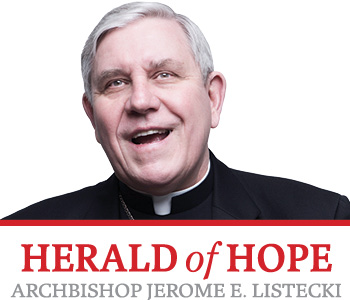Herald of Hope
Each season of the year has its own special characteristics. Spring possesses a sense of new birth, summer a sense of the fullness of life, winter embraces a deadly slumber, but fall (autumn) seems to anticipate the mystery of life as we approach the stillness of winter. Winter will come but fall begs the question – what does all this mean?
Perhaps that is why the Church in her wisdom celebrates significant holy days during the fall season. There is the feast of the Archangels, Our Lady of the Rosary, All Saints, All Souls, Presentation of the Blessed Virgin Mary, Christ the King, Advent, Immaculate Conception, Our Lady of Guadalupe, (and) a raft of popular saints (St. John Paul on Oct. 22), all leading to Christmas, which brings the light into the darkness of winter. You will not find these celebrations listed on a secular calendar with the exception of All Hallow’s Eve, which is the day before All Saints and is marked on the secular calendar as Halloween, captured by the society as a moment to celebrate witches and goblins. They do so with levity, not appreciating the evil aspects.
Our society always wishes to separate itself from anything sacred or God-related, but the real mystery of life must include God in any dialogue about life’s meaning. The late Archbishop Fulton Sheen stated: “Secularism means the separation of the parts of life – for example, education, politics and economics and family – from the center, which is God. Each department of life is considered as having the sway of ethical principles or the sovereign Law of God. Secularism reaches its peak when men say business is business, and religion is religion, as if the way a man worked or the pay he gave to workers had nothing to do with conscience and the moral fiber of a nation.” (Philosophies at War p. 35)
In the middle of the fall season, we are presented with the saints, who are models of dedicated lives, which achieves the fulfillment that all of us desire and the next day, All Souls, acknowledges our connection to all who have died. As faithful, we profess our faith on Sunday of all that is “visible and invisible.” I have always felt the influence of the saints and the presence of those who have died. They constantly remind me of the life that is awaiting all of us. But we must be responsible for the faith entrusted to us as a gift.
It is comforting to realize that God in his providence has given us the saints through the ages as guides for us as we journey through these difficult times. They are composed of all characteristics – some offered their lives and shed blood to testify to Jesus Christ, others ministered to the most vulnerable among us as they fed the poor and performed every corporal work of mercy, and there were those gifted with intellectual ability to challenge the world in its vision. These were men and women, the nobility and the poor, of every race and age. When we become confused by the society’s rationalizations that we should only depend upon man’s ability for its actions, which are contrary to the teachings of the Church, it is then that we look to our examples – the saints who declare that we must hold fast to our profession which is the path to the only true happiness.
All Souls Day allows us to connect to those who have died. Even with God’s abundant mercy, we cannot presume that our loved ones have entered the kingdom. Many funeral eulogies have all but canonized the individual. However, the doctrine of purgatory reminds us that souls will be purified after death and that we can pray for them and their sufferings can be lessened; likewise, they can pray for us and our needs. There is a beauty in the knowledge that those who shared our lives on earth continue to share in our struggles after death. I have experienced, as many have, the pain of the separation from those that have died; but in prayer, I have always experienced them close to me in every aspect of my life. As the fall asks us to consider the meaning of the mystery of life, we cannot forget the lives of those whose love pointed to something beyond us, something which is everlasting.
Christ the King Sunday is the end and the beginning. Christ is the crowning achievement of all humanity. Through Christ, our lives have been restored and it is only in him and with him that we find the purposefulness of our lives. In the fall, as the days shorten, we look to use our time to recognize his presence among us and acknowledge that our time is short and to use it wisely to further Christ’s love.
Every year, Advent calls us to prepare for the coming of our Lord. We experience in the figure of John the Baptist one who is preparing the way. The Advent season reminds us of the longing we all have for God and prepare ourselves for the fulfillment of his plan. There is an anticipation. Although we know that the culmination of this time is found in the incarnation of His Son Jesus Christ, we are surrounded by those who continue to deny him. We can only confront life’s mystery, not by answering the question of “why” but rather “who.”
The Blessed Mother is a “constancy” holding out her son to the world. She offers him as the answer. During the fall season, the celebrations of the Queen of the Rosary, Immaculate Conception, Guadalupe reveal the mystery in God’s plan and that Mary played a central role.
I enjoy the fall season. It draws me closer to the mystery of life and knowing that the winter is around the corner, I must clothe myself in the person of Christ because his life gives meaning to all things.

